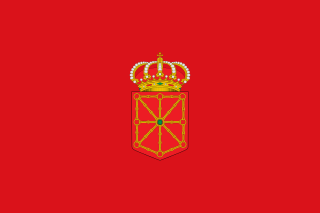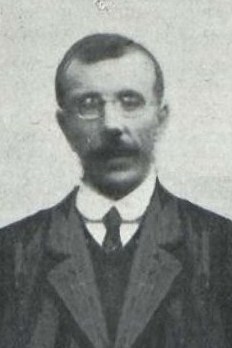
Navarre, officially the Chartered Community of Navarre, is a landlocked foral autonomous community and province in northern Spain, bordering the Basque Autonomous Community, La Rioja, and Aragon in Spain and Nouvelle-Aquitaine in France. The capital city is Pamplona. The present-day province makes up the majority of the territory of the medieval Kingdom of Navarre, a long-standing Pyrenean kingdom that occupied lands on both sides of the western Pyrenees, with its northernmost part, Lower Navarre, located in the southwest corner of France.

Ramiro I was the first King of Aragon from 1035 until his death, although he is sometimes described as a petty king. He would expand the nascent Kingdom of Aragon through his acquisition of territories, such as Sobrarbe and Ribagorza, and the city of Sangüesa. Sancho Ramírez, his son and successor, was King of Aragon, but also became King of Pamplona.
The Cagots were a persecuted minority who lived in the west of France and northern Spain: the Navarrese Pyrenees, Basque provinces, Béarn, Aragón, Gascony and Brittany. Evidence of the group exists as far back as 1000 AD.

Lower Navarre is a traditional region of the present-day French département of Pyrénées-Atlantiques. It corresponds to the northernmost merindad of the Kingdom of Navarre during the Middle Ages. After the Spanish conquest of Iberian Navarre (1512–24), this merindad was restored to the rule of the native king, Henry II. Its capitals were Saint-Jean-Pied-de-Port and Saint-Palais. In the extreme north there was the little sovereign Principality of Bidache, with an area of 1,284 km2 (496 sq mi) and a decreasing population of 44,450, 25,356.

Philip III, called the Noble or the Wise, was King of Navarre from 1328 until his death. He was born a minor member of the French royal family but gained prominence when the Capetian main line went extinct, as he and his wife and cousin, Joan II of Navarre, acquired the Iberian kingdom and a number of French fiefs.
García Íñiguez I, also known as García I was the second king of Pamplona from 851–2 until his death. He was the son of Íñigo Arista, the first king of Pamplona. Educated in Cordoba, he was a successful military leader who led the military campaigns of the kingdom during the last years of his father's life.
Ramiro Sánchez of Monzón (1070–1129/1130) was a noble kinsman of the kings of Navarre. In 1104 he was tenente of Urroz, of Monzón between 1104 and 1116, probably of Tudela in 1117 and from 1122 to 1129 in Erro.

Beaucens is a commune in the Hautes-Pyrénées department in the Occitanie region of south-western France.

Nuevo Baztán is a municipality southeast of Madrid, near Alcalá de Henares, Spain. It consists of a small historic centre and modern housing estates.

Navarro-Aragonese was a Romance language once spoken in a large part of the Ebro River basin, south of the middle Pyrenees; the dialects of the modern Aragonese language, spoken in a small portion of that territory, can be seen as its last remaining forms. The areas where Navarro-Aragonese was spoken might have included most of Aragon, southern Navarre, and La Rioja. It was also spoken across several towns of central Navarre in a multilingual environment with Occitan, where Basque was the native language.

The Abbey of Saint-Savin-en-Lavedan was a Benedictine abbey in the commune of Saint-Savin, Hautes-Pyrénées, France. It was one of the most important religious centres in the County of Bigorre. The Romanesque abbey church remains, in use since 1790 as a parish church. It has been listed since 1840 as a monument historique by the French Ministry of Culture.

The Lavedan, or occasionally vallées des Gaves, denotes a mountainous natural region of France, located at the heart of the Pyrénées, and forms a group of valleys upstream of Lourdes.

Joaquín Llorens y Fernández de Córdoba was a Spanish Carlist soldier and politician. He is known as the longest serving Carlist deputy, the longest continuously serving Carlist deputy, and the most-elected Carlist deputy. He is also recognized for turning Requeté from a vague youth organization into a military force.

Carlism was the dominant political movement in elections in Navarre during the period between the Third Carlist War and the Primo de Rivera dictatorship. The movement, defeated in 1876, during the Restauración period recalibrated its focus from military action to political means and media campaigns. Accommodating themselves to political framework of the Alfonsine monarchy, party leaders considered elections, and especially elections to Cortes Generales, primary vehicle of political mobilization. Navarre turned out to be the Carlist electoral stronghold; it elected 35% of all Carlist deputies voted into the parliament during almost 50 years of the monarchical liberal democracy. Though the phenomenon remained marginal from the national Spanish perspective, political prowess of Carlism in the province was key to sustain its potential until the movement regained momentum during the Second Spanish Republic.

Amaiur-Maya is a village in the municipality of Baztan in the autonomous region of Navarre in Spain. It is situated in the Pyrenees mountain range close to the border with France.

The Borda family is a French-Navarrese family belonging to an ancient lineage of Basque nobility. Their ancestral palace is situated in the Spanish village of Maya, present day Amaiur, in the valley of Baztán, and there is also mention of an archaic castle in Labort in the Kingdom of Aquitaine, now France, from which the family is said to have originated from.
When the Kingdom of Navarre was united with France by the marriage of Philip IV of France with Joan I Queen Regnant of Navarre and Countess of Champagne on 16 August 1284, it kept the long existing Chancery of Navarre(French: Chancellerie de Navarre). The Kings of Navarre had private Chancellors dating back to ancient kings. Theobald II of Navarre had a Vice-Chancellor, according to letters dated 1259.

José Benigno Sánchez Marco (1865-1949) was a Spanish Traditionalist politician, associated mostly with a branch known as Integrism and operating as Partido Católico Nacional, though active also within the mainstream Carlism. He is recognized as one of the longest-serving Integrist deputies to the Cortes, his 4 consecutive terms lasting between 1905 and 1916. He also presided over a number of Navarrese Catholic and landowners’ organizations.

Joaquín Beunza Redín (1872-1936) was a Spanish Carlist politician. His career climaxed in 1931–1933, when during one term he served as deputy to the Cortes; in 1909-1917 he was also member of Diputación Foral, the Navarrese self-government, and in 1901-1906 he formed part of the Pamplonese city council. He is best known for long-time efforts to preserve and broaden separate Navarrese legal establishments; he represented Pamplona in talks with Madrid during 1917-1919 negotiations on so-called reintegración foral, in 1924–1927 on so-called cupo and Convenio Económico, in 1930–1931 on Basque-Navarrese autonomy and in 1936 on separate Navarrese Carta Foral.

























